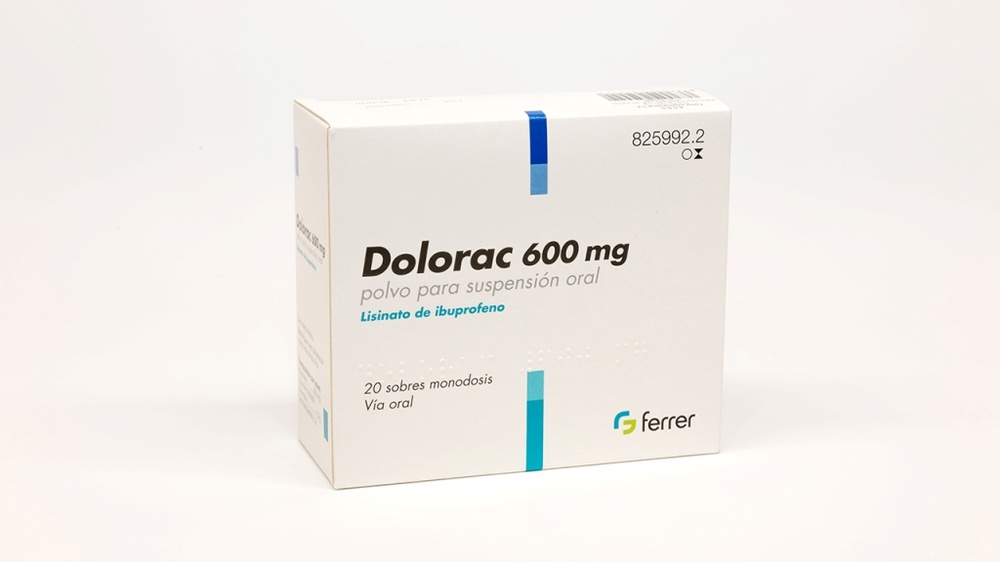

DOLORAC 600 mg ORAL SUSPENSION POWDER

Ask a doctor about a prescription for DOLORAC 600 mg ORAL SUSPENSION POWDER

How to use DOLORAC 600 mg ORAL SUSPENSION POWDER
Introduction
Package Leaflet: Information for the User
Dolorac 600 mg Powder for Oral Suspension
Ibuprofen (Lysine)
Read the entire package leaflet carefully before starting to take this medication, as it contains important information for you.
- Keep this package leaflet, as you may need to read it again.
- If you have any questions, consult your doctor or pharmacist.
- This medication has been prescribed to you only, and you should not give it to others, even if they have the same symptoms, as it may harm them.
- If you experience side effects, consult your doctor or pharmacist, even if they are not listed in this package leaflet. See section 4.
Contents of the Package Leaflet
- What is Dolorac and what is it used for
- What you need to know before taking Dolorac
- How to take Dolorac
- Possible side effects
- Storage of Dolorac
- Package Contents and Additional Information
1. What is Dolorac and what is it used for
Dolorac belongs to the group of medications called analgesics. Ibuprofen, the active ingredient of this specialty, is a non-steroidal analgesic, antipyretic, and anti-inflammatory that is presented in the form of a soluble salt (Ibuprofen Lysine).
This medication is used in the symptomatic treatment of pain, of mild to moderate intensity, and of non-chronic inflammatory processes, such as headache, toothache, post-operative pain, musculoskeletal pain, and menstrual pain.
2. What you need to know before taking Dolorac
Do not take Dolorac if:
- You are allergic (hypersensitive) to ibuprofen, any other non-steroidal anti-inflammatory, acetylsalicylic acid, or any of the excipients of this medication.
- You have previously had a stomach or duodenal hemorrhage or have suffered a perforation of the digestive tract while taking a non-steroidal anti-inflammatory medication.
- You have a worsening of an inflammatory disease of the intestines (ulcerative colitis).
- You have severe liver or kidney disease.
- You have severe heart failure.
- You are in the third trimester of pregnancy.
Warnings and Precautions
With ibuprofen, signs of allergic reaction to this medication have been reported, such as respiratory problems, swelling of the face and neck (angioedema), and chest pain. Stop using Dolorac immediately and contact your doctor or emergency services immediately if you observe any of these signs.
Consult your doctor or pharmacist before starting to take this medication.
Gastrointestinal Precautions
- If you have had or developed an ulcer, hemorrhage, or perforation in the stomach or duodenum, which may be manifested by intense or persistent abdominal pain and/or black stools, or even without prior warning symptoms.
- This risk is greater when high doses and prolonged treatments are used, in patients with a history of peptic ulcer and in elderly patients. In these cases, your doctor will consider the possibility of associating a stomach-protecting medication.
- If you have Crohn's disease or ulcerative colitis, as this medication may worsen these conditions.
Precautions with Other Medications
Inform your doctor if you are taking or have recently taken any other medication, even those purchased without a prescription, especially furosemide, thiazide diuretics, digoxin, phenytoin, lithium, methotrexate, oral hypoglycemics, insulin, zidovudine, corticosteroids, bisphosphonates, or oxypentifylline. The use of this medication with salicylates, phenylbutazone, indomethacin, or other non-steroidal anti-inflammatory medications may potentiate gastrointestinal lesions, so concomitant therapy is not recommended.
This medication may affect or be affected by other medications. For example:
- Anticoagulant medications (e.g., to treat coagulation problems/prevent coagulation, e.g., acetylsalicylic acid, warfarin, ticlopidine)
- Medications that lower high blood pressure (e.g., ACE inhibitors such as captopril, beta-blockers such as atenolol, and angiotensin II receptor antagonists such as losartan).
Other medications may also affect or be affected by treatment with this medication. Therefore, you should always consult your doctor or pharmacist before using it with other medications.
Taking Dolorac with Food, Drinks, and Alcohol
This medication can be administered independently of meals.
Consuming alcohol during treatment may increase the risk of adverse gastrointestinal reactions.
Pregnancy, Breastfeeding, and Fertility
Consult your doctor or pharmacist before using any medication.
Ibuprofen should not be taken during the third trimester (see section on precautions during pregnancy and in women of childbearing age).
The use of this medication is not recommended during breastfeeding.
Therefore, if you become pregnant or are breastfeeding, consult your doctor.
Use in Elderly Patients
Generally, no dose modification is required, although in some cases a dose reduction may be necessary.
Use in Children
The administration of this medication is not recommended in children under 12 years of age due to the amount of active ingredient it contains.
Driving and Using Machines
Ibuprofen may cause, as a rare side effect, drowsiness or dizziness, which can interfere with the ability to drive or operate machines.
Dolorac Contains Cyclodextrin (Betadex) (E-459), Tartrazine (E-102), Sucrose, and Sodium.
- This medication contains 3 g of cyclodextrin in each sachet.
- This medication may cause allergic reactions because it contains tartrazine (E-102). It can cause asthma, especially in patients allergic to acetylsalicylic acid.
- This medication contains sucrose. If your doctor has told you that you have an intolerance to certain sugars, consult with them before taking this medication. It can cause cavities.
- This medication contains less than 1 mmol (23 mg) per sachet, which is essentially "sodium-free".
3. How to Take Dolorac
Follow the administration instructions of this medication exactly as indicated by your doctor or pharmacist. In case of doubt, consult your doctor or pharmacist again.
The lowest effective dose should be used for the shortest time necessary to alleviate symptoms. If you have an infection, consult your doctor without delay if the symptoms (such as fever and pain) persist or worsen (see section 2).
Adults
In adults and adolescents from 14 years of age, one sachet (600 mg of ibuprofen) is recommended every 6-8 hours, depending on the intensity of the symptoms and the evolution of the treatment.
Generally, the recommended daily dose is 1200 mg of ibuprofen, divided into 3 or 4 doses. In some treatments, higher doses may be required, but in any case, it is recommended not to exceed the maximum daily dose of 2400 mg of ibuprofen in adults and 1600 mg in adolescents from 12 to 18 years of age.
Children
The use of this medication is not recommended in children and adolescents under 14 years of age due to the amount of active ingredient it contains.
Elderly Patients
It is possible that your doctor will prescribe a lower dose than usual. If so, the dose can only be increased once your doctor has verified that you tolerate the medication well.
Patients with Kidney and/or Liver Disease
If you have kidney and/or liver disease, it is possible that your doctor will prescribe a lower dose than usual. If so, take the exact dose that your doctor has prescribed.
Method of Administration
For oral administration.
Pour the contents of one sachet into a half glass of water, stir, and take immediately.
Patients with stomach discomfort should take the medication during meals.
If You Take More Dolorac Than You Should
If you have taken more medication than you should, or if a child has accidentally ingested the medication, consult your doctor or pharmacist immediately, go to the nearest hospital, or call the Toxicology Information Service (telephone 91 562 04 20) indicating the medication and the amount ingested, to find out about the risk and ask for advice on the measures to be taken.
The symptoms of overdose may include nausea, stomach pain, vomiting (which may contain blood), headache, ringing in the ears, confusion, and involuntary eye movement. At high doses, symptoms such as drowsiness, chest pain, palpitations, loss of consciousness, convulsions (mainly in children), weakness, and dizziness, blood in the urine, chills, and breathing problems have been reported.
In case of ingestion of significant amounts, activated charcoal should be administered. Gastric lavage will be considered if significant amounts have been ingested and within 60 minutes after ingestion.
If You Forget to Take Dolorac
Do not take a double dose to make up for forgotten doses.
If you forget to take your corresponding dose, take it as soon as you remember. However, if the time for the next dose is near, skip the forgotten dose and take the next dose at the usual time.
If you have any other questions about the use of the medication, ask your doctor or pharmacist.
4. Possible Side Effects
Like all medications, this medication can have side effects, although not everyone will experience them.
The side effects observed are described below according to their frequency: very common (may affect more than 1 in 10 patients); common (may affect up to 1 in 10 patients); uncommon (may affect up to 1 in 100 patients); rare (may affect up to 1 in 1,000 patients); very rare (may affect up to 1 in 10,000 patients); frequency not known (cannot be estimated from available data).
Gastrointestinal:
The most common side effects that may occur are gastrointestinal: peptic ulcers, gastrointestinal bleeding, perforations (in some cases fatal), especially in elderly patients. Nausea, vomiting, diarrhea, flatulence, constipation, heartburn, abdominal pain, blood in stools, oral ulcers, worsening of ulcerative colitis, and Crohn's disease have also been observed. Less frequently, gastritis has been observed.
Skin and Subcutaneous Tissue:
It can be associated, in very rare cases, with severe blistering reactions such as Stevens-Johnson Syndrome and Toxic Epidermal Necrolysis.
Rarely, hypersensitivity reactions may occur, which manifest as a rash with more or less itching.
A severe skin reaction known as DRESS syndrome can occur. The symptoms of DRESS syndrome include: skin rash, lymph node inflammation, and elevated eosinophils (a type of white blood cell).
Frequency "not known": Generalized red scaly rash, with bumps under the skin and blisters, mainly on the skin folds, trunk, and upper limbs, accompanied by fever at the start of treatment (exfoliative dermatitis, erythema multiforme, Stevens-Johnson syndrome, toxic epidermal necrolysis). Stop taking this medication if you experience these symptoms and seek medical attention immediately. See also section 2. The skin becomes sensitive to light.
Cardiac and Vascular:
It can be associated with a moderate increase in the risk of suffering a heart attack ("myocardial infarction") or stroke.
Edema (fluid retention), high blood pressure, and heart failure have also been observed in association with treatment with this medication.
Frequency not known: Chest pain, which can be a symptom of a potentially serious allergic reaction called Kounis syndrome.
Hepatobiliary:
It can be associated, in rare cases, with liver damage.
Immune System:
Cases of aseptic meningitis (inflammation of the membranes that cover the brain and spinal cord) have been reported, mostly in patients with some autoimmune disease such as systemic lupus erythematosus.
Nervous System:
Rarely, headache and drowsiness may occur. Aseptic meningitis (see immune system).
Psychiatric:
Neurological reactions such as depression, confusion, and dizziness
Ear and Labyrinth:
Rarely, ringing in the ears may occur
Eye:
Visual disturbances
Blood and Lymphatic System:
After prolonged administration and at high doses, it can cause changes in blood cells.
Respiratory, Thoracic, and Mediastinal:
With low incidence, and in any case in predisposed patients, it can lead to bronchospasm (contraction of the bronchi).
If any of the following side effects occur, stop treatment and consult your doctor immediately:
- Reddish, non-elevated spots, in a target or circular shape on the trunk, often with blisters in the center, skin peeling, mouth ulcers, throat ulcers, nose ulcers, genital ulcers, and eye ulcers. These severe skin rashes can be preceded by fever and flu-like symptoms (exfoliative dermatitis, erythema multiforme, Stevens-Johnson syndrome, toxic epidermal necrolysis).
- Generalized skin rash, elevated body temperature, and swollen lymph nodes (DRESS syndrome).
- Generalized, red, and scaly rash, with bumps under the skin and blisters, accompanied by fever. The symptoms usually appear at the start of treatment (acute generalized exanthematous pustulosis). Stop taking this medication if you experience these symptoms and seek medical attention immediately.
Reporting Side Effects
If you experience any type of side effect, consult your doctor, pharmacist, or nurse, including possible side effects that are not listed in this package leaflet. You can also report them directly through the Spanish Pharmacovigilance System for Human Use Medications: https://www.notificaram.es. By reporting side effects, you can contribute to providing more information on the safety of this medication.
5. Storage of Dolorac
No special storage conditions are required.
Keep this medicine out of the sight and reach of children.
Do not use this medicine after the expiry date that appears on the packaging after (EXP). The expiry date is the last day of the month indicated.
Medicines should not be disposed of via wastewater or household waste. Deposit the packaging and any unused medicines at the SIGRE collection point in your pharmacy. Ask your pharmacist how to dispose of the packaging and any unused medicines. This will help protect the environment.
6. Package Contents and Additional Information
Composition of Dolorac
- The active ingredient is ibuprofen. Each sachet contains 600 mg of Ibuprofen (provided by 1025 mg of Ibuprofen lysine).
- The other ingredients (excipients) are betadex (E-459), lemon flavor (contains tartrazine (E-102), corn starch, and corn maltodextrin), sodium saccharin, sodium cyclamate, sodium citrate, and sucrose.
Appearance of Doloracand Package Contents
It is presented as a white powder, packaged in sachets.
Each package contains 20 or 40 single-dose sachets.
Marketing Authorization Holder and Manufacturer
LABORATORIO DE APLICACIONES FARMACODINÁMICAS, S.A.
Grassot, 16 - 08025- Barcelona (Spain)
Date of the Last Revision of this Leaflet:January 2024
Detailed and updated information on this medicine is available on the website of the Spanish Agency for Medicines and Health Products (AEMPS) http://www.aemps.gob.es/
- Country of registration
- Active substance
- Prescription requiredYes
- Manufacturer
- This information is for reference only and does not constitute medical advice. Always consult a licensed doctor before taking any medication. Oladoctor is not responsible for medical decisions based on this content.
- Alternatives to DOLORAC 600 mg ORAL SUSPENSION POWDERDosage form: ORAL SOLUTION/SUSPENSION, 600 mg ibuprofenActive substance: ibuprofenManufacturer: Laboratorio De Aplicaciones Farmacodinamicas S.A.Prescription requiredDosage form: ORAL SOLUTION/SUSPENSION, 200 mgActive substance: ibuprofenManufacturer: Laboratorio De Aplicaciones Farmacodinamicas S.A.Prescription requiredDosage form: ORAL SOLUTION/SUSPENSION, 20 mg/mlActive substance: ibuprofenManufacturer: Laboratorio De Aplicaciones Farmacodinamicas S.A.Prescription required
Alternatives to DOLORAC 600 mg ORAL SUSPENSION POWDER in other countries
The best alternatives with the same active ingredient and therapeutic effect.
Alternative to DOLORAC 600 mg ORAL SUSPENSION POWDER in Poland
Alternative to DOLORAC 600 mg ORAL SUSPENSION POWDER in Ukraine
Online doctors for DOLORAC 600 mg ORAL SUSPENSION POWDER
Discuss dosage, side effects, interactions, contraindications, and prescription renewal for DOLORAC 600 mg ORAL SUSPENSION POWDER – subject to medical assessment and local rules.















